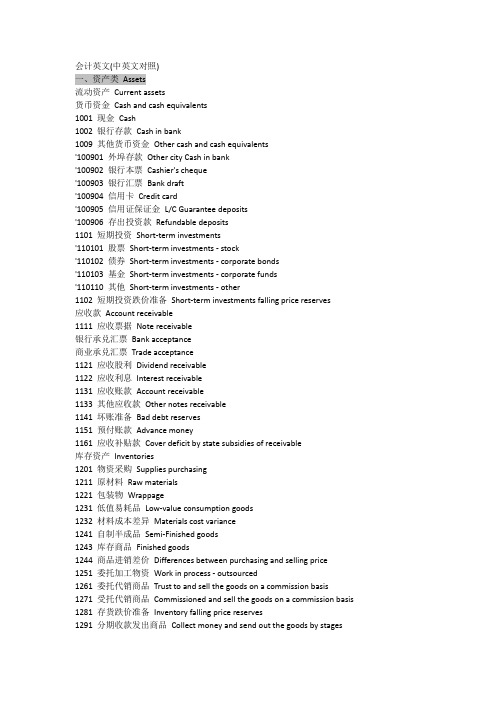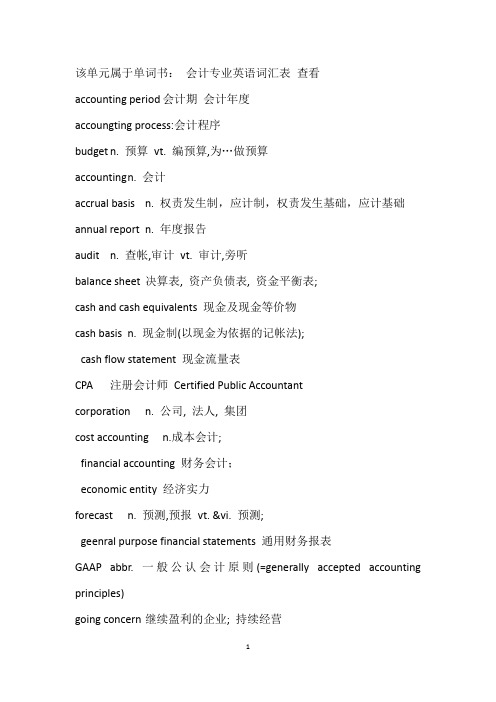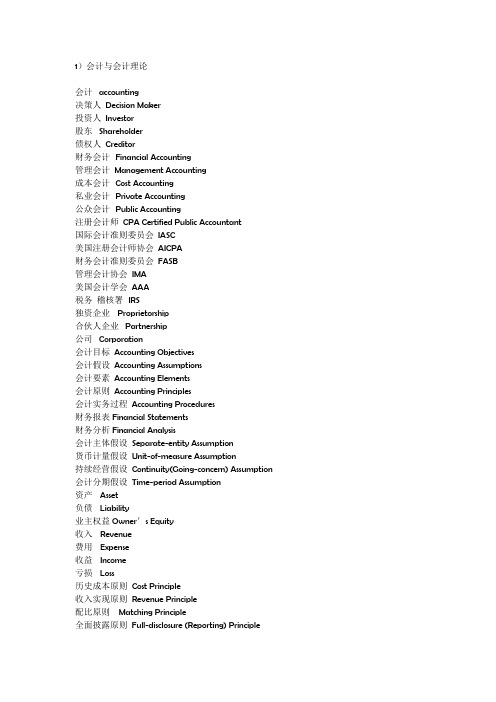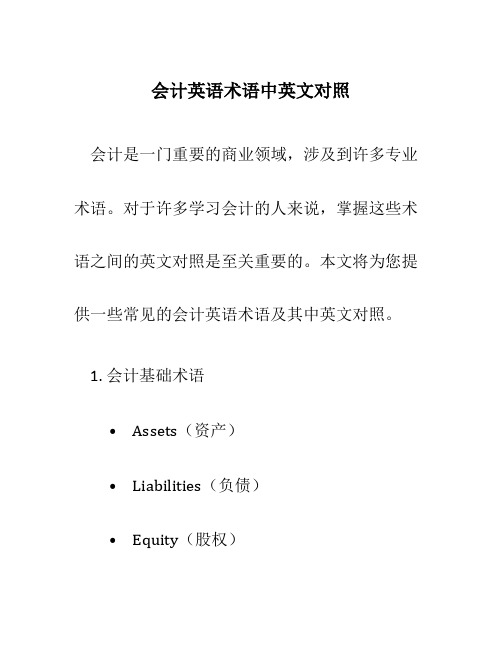会计英语词汇解释
会计专业英语词汇整理

英文顺序Aa set of 一组,一套accelerated depreciation method 加速折旧法access 接近account 账户,会计科目accountability 会计责任accountant 会计人员accounting activity 会计活动accounting control 会计控制accounting cycle 会计循环accounting entity 会计主体accounting equation 会计等式,会计平衡式,会计方程式accounting period 会计期间accounting principle board 会计原则委员会accounting principle 公认会计原则accounting principles board 会计原则委员会accounting process 会计过程,会计处理方法accounting 会计,会计学accounts payable 应付账款accounts receivable 应收账款accrual basis 权责发生制accruals 应计项目accrue 自然累积,计提accrued expense 应计费用,应计未付费用accrued revenue 应计收入,应计未收收入accrued salaries payable 应计未付薪金accumulate 累积accumulated depreciation 累计折旧acquire 并购acquisition 取得active investment 主动投资adding machine 加法机adjusting procedure 调整程序adjustment 调整administrative control 管理控制administrative expense 管理费用advance 预付款advertising expense 广告费advice slip 通知单affiliated company 关联公司affiliated group 联营集团agency 机构,经理人aggregate 合计的aging schedule 账龄分析法align 调准,使成一线,使一致allowance for uncollectible accounts 备抵坏账allowance method 备抵法alternative 可供选择的american institute of certified public accountants 美国注册会计师协会amortization 摊销annual interest rate 年利率annually 每年地apportion 分配,摊配appropriate 适当的,相应的appropriation 分拨approve 批准arrearage 拖欠款arrest 阻止aspect 容貌,样式,表现形式asset turnover 资产周转率asset 资产assignment of responsibility 分派责任assumption 假设assure 保证at a glance 一瞥attorneys' fees 律师事务费attribute 属性attribute 属性auditing 审计auditor 审计员authorization 授权authorized stock 额定股本automated data processing 自动数据处理auxiliary equipment 辅助设备average collection period 平均收帐期average exchange rate 平均汇率Bbad debts expense 坏账费用balance sheet 平衡表,资产负债表bank deposit 银行存款bank reconciliation 银行往来调节表bank statement 银行对账单,银行结单bearer 持票人beginning inventory 期初存货betterment 改良billed price 账单价格board of directors 董事会bonds payable 应付债券,应付公司债book value 账面价值book value 账面价值bookkeeping machine 簿记机brand 商标bring……to light 揭露budgetary accounting 预算会计budgets 预算bundle 束,捆,集合体business venture 企业by means of 利用,依靠,通过Ccalculator 计算器calendar-year 日历年度capital stock 股本carrier 运输业者carrying value 置存价值,账面价值cash basis 收付实现制cash budget 现金预算cash disbursements journal 现金支出日记账cash discount 现金折扣cash dividend 现金股利cash in bank 银行存款cash on delivery 付款提货cash receipts journal 现金收入日记账cash 现金casualty loss 事故损失category 种类,类目,范畴central processing unit 中央处理单元certified public accountings 注册会计师chart of accounts 账户一览表,会计科目表charter 执照,发给……执照check stub 支票存根check 支票chronological 按时间顺序的claim 要求classification and sorting 分类整理clear 结清,结算,交换票据closing procedure 结帐程序closing rate 期末汇率code letter 代号字母coin 硬币,铸币committee on accounting procedure 会计程序委员会common stock 普通股comparable 可比的,类似的competent personnel 称职的人员complex capital structure 复杂资本结构complexity 复杂性comply with 遵守,遵循concept 概念confer 参见conservation 稳健的consideration 对家,报酬consolidate 合并constructed assets 建造资产consultant 顾问consume 消费contend 坚决主张contingent liability 或有负债continuity of existence 存在的连续性contra account 对抵账户,对销账户control account 控制账户,统驭账户,统制账户convention 惯例convert 转变,变换,兑换convertible debt 可转换债券convertible preferred stock 可转换优先股copyrights 版权copyrights 版权corporation acquisition 公司并购,公司收购corporation 股份有限公司correction of prior period inventory error 前期盘存差错订正cost accounting 成本会计cost method 成本法cost of goods available for sale 可供销售的商品成本cost of goods sold 销货成本,商品销售成本cost structure 成本结构cost-benefit data 成本-效益数据cost-to-retail price percentage 成本对零售价比率court decree 法庭判决cpital contribution 资本投入credit memo 货项通知单,货记通知单credit standing 信用地位,信誉credit term 赊账条件credit 贷记creditor 债权人cross rates 套算汇率cumulative balance 累计余额current asset 流动资产current exchange rate 现行汇率,现时汇率current fair value 现时公允价值current liability 流动负债current rate method 现行汇率法,现时汇率法current ratio 流动比率current-noncurrent method 流动与非流动项目法custodianship 保管工作customary matters 惯常业务customer 顾客cuttings 切削件D datapreparation 数据准备debenture bonds 信用公司债debit memo 借项通知单debit 借机debtor 债务人decision making 决策deferrals 递延项目deferred credit 递延货项deficits 逆差denominate 标价,表述denominator 分母department stores 订货商店depletion 折耗depreciable asset 应折旧资产depreciation expense 折旧费design cost 设计成本design 计划,设计,意图,打算designate 指明remit 汇款,付款detect 发现,察觉deterioration 损坏dilute 稀释,摊薄direct quote 直接标价direct write-off method 直接销账法director 董事会discharge 履行,清偿discount on notes payable 应付票据贴现折价discount 折价discount 折价,贴水discount 贴现,贴现折价discretion 自由决定dishonor 拒付dispose 处置,清理disposition data 清理数据diverse 多宗多样的dividend payable 应付股利dividend payout ratio 每股股利与收益比率,股利支付率dividend yield 每股股利与每股市价比率,股利获取division of labor 分工double-declining-balance method 双倍率递减余额法double-entry bookkeeping system 复式记账法,复式记账系统draft 汇票draw (up)拟好,编好draw up 开立(票据等)drillings 钻孔件Eearning per share 每股收益额earnings per share of common stock 普通股每股收益额earthquake 地震effective interest method 实际利息法elapse 过去electronic data processing system 电子数据处理系统eliminate 消除elimination 抵消,消除ending inventory 期末存货endorse 背书endorsement 背书endorser 背书人engage in 参与entend 把数字转入另一栏,算出……的总金额enter contract 缔结契约enumerate 列举environmental accounting 环境会计equity method 权益法equity ratio 权益比率equivalent 等同的,等同物,当量error correction 差错订正estate 不动产evaluate 评价event 事件excess of par value over amount paid 面值超过缴入资本的部分exchange rate 汇率exclusive privilege 专有权利expedient 权宜的做法expenditure 开支,花费expense 费用expire 满期,耗尽,失效extension 算出或转来的金额extensive 广泛的extraordinary items 非常项目FF.O.B destination 目的地交货,到达站交货F.O.B shipping point 发运地(站)交货face value 面值face value 票面价值factor 代替factor 因素,系数family 类属feasible 行得通的federal income tax withholding payable 应付预扣联邦所得税federal insurance contributions act 联邦社会保险税法federal unemployment compensation tax州失业补贴税federal unemployment tax payable 应付州失业税federal 联邦federal 联邦的fencing 栅栏FICA tax payable 应付联邦社会保险税financial accounting standards board 财务会计准则委员会financial accounting 财务会计financial data 财务数据financial executives 财务经理financial income and expense 财务收益与费用financial position 财务状况financial report 财务报告financial statement(report)财务报表(报告)financial strength 财务实力financing activities 筹资活动,理财活动firm 事务所firm 商行,企业first-in,fist-out 先进先出fiscal year 财务年度fiscal year 财务年度fixed assets 固定资产flow of costs 成本流动flow of goods 商品流动fluctuate 波动footing 总计,总额forecast 预测foreign currency 外币foreign exchange gains or losses 汇兑损益,汇兑利得或损失forward exchange contract 期汇合同forward rate 远期汇率fraction 分数franchise 特许经营权freight collect 货到收运费freight prepaid 运费预付frequency 频繁程度fully diluted earnings per share 每股完全稀释收益额function 职能,作用functional currency 功能货币fund 资金Ggain(loss)on sale of fixed assets 固定资产出售利得(损失)general journal 普通日记账general partnership 一般合伙globalization 全球化going concern 持续经营goodwill 商誉governmental accounting 政府会计governmental and not-for-profit accounting 政府及非盈利组织会计gross profit method of estimating inventories 估计存货的毛利法gross profit on sales 销货毛利gross sales 销货总额net sales 销货净额guide 指南guideline 方针,准则Hhardware 硬件haul 拖运historical cost 历史成本historical cost 历史成本historical exchange rate 历史汇率holder 持票人holdings 拥有的财产、股份hospital insurance premiums payable 应付医疗保险费human resources accounting 人力资源会计Iimmune 免受影响的impairment loss 减值损失imprest 预付的,定额预付的,定额备用的in addition to 除……外in contrast to 与此对比,与此相反in order to 为了,借以in place of 代替in sequence 按顺序,依次in short 简言之,总之in the final analysis 归根到底,总之income statement 收益表,损益表income summary 收益汇总,损益汇总income tax payable 应付所得税income tax reporting 所得税申报indirect quote 间接标价individual employee earnings records 雇员个人工薪记录information return 资料申报单information system 信息系统input 投入数额instruction 指令insurance expense 保险费insurance premium 保险费intangible asset 无形资产intangible assets 无形资产intercompany transaction 公司间交易interest allowance 利息补贴interest bearing 计息的interest coverage 利息保障范围interest expense 利息费用interest income 利息收益interim financial statement 中期财务报表interim mechanical check 中间性的手工操作检查intermediate 中间的,居间的internal auditing 内部审计internal control 内部控制international accounting 国际会计inventory turnover 存货周转率investing activities 投资活动investor 投资者invoice register 发票登记薄involve(in)使卷入IOU 借据irregularity 不正当行为issued stock 已发行股本Jjournal 日记账journalize 做分录Kkey-driven equipment 键盘式装置设备Llast-in,first-out 后进新出leasehold 租赁权ledger 分类账legal jurisdiction 法定管辖范围legal restrictions 法律约束liability 负债liability 负债limited partnership 有限合伙liquidation value 清算价值liquidity 变现能力,清偿能力list of checks 支票目录local 地方logic 逻辑判断的logically 合乎逻辑地,理所当然地long-term asset 长期资产loss from doubtful accounts 疑账损失,呆帐损失loss from uncollectible accounts 坏账损失lubrication 加润滑油Mmaintenance 维修majority investor 多数股权投资者,控股投资者majority 多数股权majority-owned company 被控股公司maker 出票人make-up 标价managerial accounting 管理会计manual filing 手工归档manufacturer's identification 制造厂商鉴定书margin of safety 安全边际marital status 婚姻状况market value 市场价值marketable securities 上市证券,有价证券maturity date 到期日measuring unit 计量单位meet 如期偿付merchandising company 商业公司minor parts 次要零件minority interest 少数股权,少数股东权益minority 少数股权misappropriation 挪用miscellaneous expense 杂项费用mix 品种构成model number 型号modern business 现代企业monetary assets and liabilities 货币性资产与负债monetary-nonmonetary method 货币性与非货币性项目法money order 汇票mortgage payable 应付抵押借款mortgage 抵押multinational company 跨国公司Nnatural assets 天然资产necessitate 使成为必须negative goodwill 负商誉negotiable 可流通的neither nor 既不又不net income 净收益net loss 净亏损net purchases 购货净额nominal interest rate 名义利率nongovernment body 非政府机构normal balance 正常余额normal operating cycle 正常经营周期normal rate of return 正常盈利率notes payable 应付票据notes receivable discounted 贴现应收票据notification 通知NSF(not sufficient funds)存款不足numerator 分子Oobjectivity 客观性obligation 义务,债务obsolescence 陈旧,过时office salaries expense 办事人员薪金on demand (票据)即期(支付)one-transaction perspective 单项交易观点,单一交易观点open account 往来账户operating activities 经营活动,营业活动operating expenses 营业费用,经营费用operating results 经营成果operation 经营,操作operational efficiency 经营效率opinion No.17 第17号意见书opposite 在……的对面organization cost 开办费original cost 原始成本other than 除……外,除了outlay 支出outstanding check 未兑付支票outstanding stock 外发股本,为股东持有的股本outstanding 未兑付的overdraft 透支overdrew 透支overtime pay 加班工资owner' equity 业主权益Ppaid-in capital in excess of par value 超过面值的缴入资本paid-in capital in excess of stated value 超过设定价值的缴入资本paper tape output 纸带输出par value 面值parent 母公司participating stock 参与分配的优先股partnership 合伙passive investment 被动投资patent 专利权pay attention to 注意pay envelope 工薪袋pay period 工薪支付期payroll accounting 工薪会计payroll payable 应付工薪payroll register 工薪登记表payroll tax 工薪税payroll 工薪perforate 穿孔于performance report 业绩报告performance 工作成绩,业绩performance 经营业绩periodic inventory system 定期盘存制peripheral equipment 边缘设备perishable 易腐坏的perpetual inventory system 永续盘存制petty cash 零用现金physical inventory counts 实物盘点physical protection 实物保护pipeline 管道plant and equipment 厂场设备plausible 看来有理由的pledge 保证,抵押pluged figure 轧算金额pooling of interest method 权益结合法,权益入股法portray 描述,描绘post 过账,誊账post-closing trial balance 结帐后试算表postdated check 远期支票posting reference 过账备查,过账记号potential 潜力,潜能potential 潜在的,可能的pound sterling 英镑preferable 更可取的preferred dividend coverage 优先股股利保障范围preferred stock 优先股premium 溢价premium 溢价,升水prepaid insurance 预付保险费prescribed managerial policies 规定的管理方针price lists 价目表price-earning ratio 每股市价与收益比率,市盈率primary earnings per share 每股原先收益额principal 主要的private accounting 私人企业会计proceeds 实得收入productivity ratio 生产能力比率profitability 盈利能力programming 程序编制promise 订约,允诺promissory note 本票,期票property tax payable 应付财产税property 动产prospective 预期的,未来的protest fee 拒付证书费public accounting firms 会计师事务所public accounting 公众会计,注册会计师业务public utility 公用事业publisher 出版商punched card 穿孔卡purchase invoice 购货发票purchase method 购买法,购并法purchase order 订货单purchase order 订货单,订购单purchase requisition 请购单purchases discounts 购货折扣purchases journals 购买日记账purchases returns and allowances 购货退让及折扣purchasing department 购货部门Qquick ratio 速动比率quotation 行情表quote 报价Rrate of return on common stockholders' equity 普通股股东权益收益率rate of return 报酬率,盈利率,收益率rates of inflation 通货膨胀率rather than 而不是realizable 可实现的realty agency 房地产经纪人receiving department 收货部门receiving report 收货报告receiving report 收货报告,收货单recognized value 确认价值recommend 推荐,介绍reconciliation method 调节法records of original entry 原始记录簿registration fees 注册费regular rate of pay 正常工资率relate to 与……有关rent expense 租赁费,租金reorder points 再订货点replace 取代replenishment 补充reporting currency 报告货币residual 剩余的resource 资源,资财result 结果,成果retail businesses 零售商店retail price 零售价格retained earnings 留存收益,保留盈利retrieval 追溯return on sales 销售收益率returned item 退回项目revenue 收入reversing entry 转回分录rule of thumb 拇指法则,经验规律running balance 逐笔结记余额Ssalary allowance 薪金补贴sales discounts 销货折扣sales invoice 销货发票sales journal 销货日记账sales on credit terms 赊销sales returns and allowances 销售退回及折让sales salaries expense 销货人员薪金salvage value 残值savings bonds deductions payable 应付购买储蓄债券扣款savings 节约scheme 方案,计划scrutiny 仔细检查secured bonds 有担保债券security/stock exchange 证券交易所segregate 分开segregation 分开selling expenses 销货费用semiannually 半年地serial number 顺序编号service charge 服务费service enterprise 服务业企业sharing agreement 分配协议short-term liquidity 短期偿债能力simple capital structure 简单资本结构sinking fund 偿债基金site 地基social accounting 社会会计software 软件sole proprietorship 独资source document 原始凭证special journal 特种日记账specific identification 具体辨认specific payee 指定收款人spectrum 范围spot rate 即期汇率stampings 冲压件standard 准则state corporation law 州公司法state 州stated value 设定价值statement of cash flows 现金流量表statement of cash flows 现金流量表statement of financial accounting standards 财务会计准则公告statement of owners' equity 业主权益表statement of owners'equity 业主权益表stock dividend to be issued 待发行股票股利stock dividend 股票股利stock options 股票期权stock warrants 认股权stock 存货stockholder 股东stock-option 股票期权storage tank 储存罐storage 存储store fixtures 店面装置store 仓库straight-line method 直线法strta 层,级style-affected 受式样影响的subdivision 分支submit 提交subscription 预订subsidiary company 子公司subsidiary ledger 辅助分类账,明细分类账subsidiary 子公司subtract 减去sum-of-the-year's-digits method 年数总和法sundry items 其他项目supersede 代替,取代supplies' catalogs 供应商商品目录supplies expense 物料用品费supplies on hand 在用物料surface paving 铺筑的路面surplus 顺差susceptible 易受影响的Ttax accounting 税务会计tax returns 纳税申报单temporal method 时态法,时间量度法temporary account 暂时性帐户,过渡性账户temporary accounts 暂时性账户throughout 贯穿trade payable 应付账款trade receivable 应收账款trademark 商标,商标权transaction 交易,会计事项transcribe 抄录transfer 转移transferability 可转移性translation gains and losses 折算损益,折算利得与损失transportation in 购货运费transportation out 销货运费transportation term 运输条件treasury stock 库存股本,库存股份trial balance 试算平衡表,试算表two-column account 两栏式账户two-transactions perspective 两项交易观点U uncollectible accounts expense 坏账费用undistributed earnings 未分配收益,未分配盈利uniform limited partnership act 统一有限合伙法uniform 一致的,均匀的units-of-production method 产量法upkeep 维护,保养utilities expense 公共事业费Vvendor 卖主verification 验证voluntary 自愿的voting share 有表决权股份voucher register 应付凭单登记簿voucher system 应付凭单制Wwage-bracket table 工资-税级表warrant 使有理由wear 磨损weighted average 加权平均withdraw 提取withhold 预扣withholding allowance 预扣折让without recourse 无追索权working capital 营运资本worksheet 工作底表,工作底稿按汉字顺序Amargin of safety 安全边际chronological 按时间顺序的in sequence 按顺序,依次Bentend 把数字转入另一栏,算出……的总金额copyrights 版权office salaries expense 办事人员薪金semiannually 半年地custodianship 保管工作insurance premium 保险费insurance expense 保险费assure 保证pledge 保证,抵押rate of return 报酬率,盈利率,收益率reporting currency 报告货币quote 报价allowance method 备抵法allowance for uncollectible accounts 备抵坏账endorsement 背书endorse 背书endorser 背书人passive investment 被动投资majority-owned company 被控股公司promissory note 本票,期票peripheral equipment 边缘设备liquidity 变现能力,清偿能力make-up 标价denominate 标价,表述acquire 并购fluctuate 波动replenishment 补充estate 不动产irregularity 不正当行为bookkeeping machine 簿记机Cfinancial statement(report)财务报表(报告)financial report 财务报告financial accounting 财务会计statement of financial accounting standards 财务会计准则公告financial accounting standards board 财务会计准则委员会financial executives 财务经理fiscal year 财务年度financial strength 财务实力financial income and expense 财务收益与费用financial data 财务数据financial position 财务状况confer 参见engage in 参与participating stock 参与分配的优先股salvage value 残值store 仓库strta 层,级error correction 差错订正units-of-production method 产量法sinking fund 偿债基金plant and equipment 厂场设备transcribe 抄录paid-in capital in excess of par value 超过面值的缴入资本paid-in capital in excess of stated value 超过设定价值的缴入资本obsolescence 陈旧,过时competent personnel 称职的人员cost-to-retail price percentage 成本对零售价比率cost method 成本法cost accounting 成本会计cost structure 成本结构flow of costs 成本流动cost-benefit data 成本-效益数据programming 程序编制holder 持票人bearer 持票人going concern 持续经营stampings 冲压件financing activities 筹资活动,理财活动publisher 出版商maker 出票人in addition to 除……外other than 除……外,除了storage tank 储存罐dispose 处置,清理punched card 穿孔卡perforate 穿孔于minor parts 次要零件storage 存储stock 存货inventory turnover 存货周转率NSF(not sufficient funds)存款不足continuity of existence 存在的连续性Dcode letter 代号字母in place of 代替factor 代替supersede 代替,取代credit 贷记stock dividend to be issued 待发行股票股利one-transaction perspective 单项交易观点,单一交易观点maturity date 到期日equivalent 等同的,等同物,当量elimination 抵消,消除mortgage 抵押local 地方site 地基earthquake 地震deferred credit 递延货项deferrals 递延项目opinion No.17 第17号意见书enter contract 缔结契约electronic data processing system 电子数据处理系统store fixtures 店面装置purchase order 订货单purchase order 订货单,订购单department stores 订货商店promise 订约,允诺periodic inventory system 定期盘存制director 董事会board of directors 董事会property 动产sole proprietorship 独资short-term liquidity 短期偿债能力contra account 对抵账户,对销账户consideration 对家,报酬majority 多数股权majority investor 多数股权投资者,控股投资者diverse 多种多样的Eauthorized stock 额定股本rather than 而不是invoice register 发票登记薄Fdetect 发现,察觉F.O.B shipping point 发运地(站)交货legal jurisdiction 法定管辖范围legal restrictions 法律约束court decree 法庭判决spectrum 范围scheme 方案,计划guideline 方针,准则realty agency 房地产经纪人extraordinary items 非常项目nongovernment body 非政府机构expense 费用appropriation 分拨division of labor 分工segregation 分开segregate 分开ledger 分类账classification and sorting 分类整理denominator 分母assignment of responsibility 分派责任apportion 分配,摊配sharing agreement 分配协议fraction 分数subdivision 分支numerator 分子service charge 服务费service enterprise 服务业企业subsidiary ledger 辅助分类账,明细分类账auxiliary equipment 辅助设备cash on delivery 付款提货negative goodwill 负商誉liability 负债liability 负债double-entry bookkeeping system 复式记账法,复式记账系统complexity 复杂性complex capital structure 复杂资本结构Gbetterment 改良concept 概念preferable 更可取的payroll 工薪pay envelope 工薪袋payroll register 工薪登记表payroll accounting 工薪会计payroll tax 工薪税pay period 工薪支付期wage-bracket table 工资-税级表performance 工作成绩,业绩worksheet 工作底表,工作底稿utilities expense 公共事业费accounting principle 公认会计原则corporation acquisition 公司并购,公司收购intercompany transaction 公司间交易public utility 公用事业public accounting 公众会计,注册会计师业务functional currency 功能货币supplies' catalogs 供应商商品目录purchasing department 购货部门purchase invoice 购货发票net purchases 购货净额purchases returns and allowances 购货退让及折扣transportation in 购货运费purchases discounts 购货折扣purchase method 购买法,购并法purchases journals 购买日记账gross profit method of estimating inventories 估计存货的毛利法capital stock 股本stockholder 股东corporation 股份有限公司stock dividend 股票股利stock-option 股票期权stock options 股票期权fixed assets 固定资产gain(loss)on sale of fixed assets 固定资产出售利得(损失)customer 顾客consultant 顾问individual employee earnings records 雇员个人工薪记录affiliated company 关联公司pipeline 管道administrative expense 管理费用managerial accounting 管理会计administrative control 管理控制throughout 贯穿customary matters 惯常业务convention 惯例extensive 广泛的advertising expense 广告费in the final analysis 归根到底,总之prescribed managerial policies 规定的管理方针international accounting 国际会计elapse 过去post 过账,誊账posting reference 过账备查,过账记号Hfeasible 行得通的quotation 行情表consolidate 合并logically 合乎逻辑地,理所当然地partnership 合伙aggregate 合计的last-in,first-out 后进新出uncollectible accounts expense 坏账费用bad debts expense 坏账费用loss from uncollectible accounts 坏账损失environmental accounting 环境会计foreign exchange gains or losses 汇兑损益,汇兑利得或损失exchange rate 汇率money order 汇票draft 汇票marital status 婚姻状况contingent liability 或有负债monetary-nonmonetary method 货币性与非货币性项目法monetary assets and liabilities 货币性资产与负债freight collect 货到收运费credit memo 货项通知单,货记通知单K(会计……)accounting 会计,会计学committee on accounting procedure 会计程序委员会accounting equation 会计等式,会计平衡式,会计方程式accounting process 会计过程,会计处理方法accounting activity 会计活动accounting control 会计控制accounting period 会计期间accountant 会计人员public accounting firms 会计师事务所accounting cycle 会计循环accounting principles board 会计原则委员会accounting principle board 会计原则委员会accountability 会计责任accounting entity 会计主体Jagency 机构,经理人on demand (票据)即期(支付)spot rate 即期汇率design 计划,设计,意图,打算measuring unit 计量单位calculator 计算器interest bearing 计息的neither nor 既不又不overtime pay 加班工资adding machine 加法机weighted average 加权平均lubrication 加润滑油accelerated depreciation method 加速折旧法assumption 假设price lists 价目表contend 坚决主张indirect quote 间接标价subtract 减去impairment loss 减值损失simple capital structure 简单资本结构in short 简言之,总之constructed assets 建造资产key-driven equipment 键盘式装置设备transaction 交易,会计事项access 接近bring……to light 揭露savings 节约result 结果,成果clear 结清,结算,交换票据closing procedure 结帐程序post-closing trial balance 结帐后试算表debit 借机IOU 借据debit memo 借项通知单operation 经营,操作operating results 经营成果operating activities 经营活动,营业活动operational efficiency 经营效率performance 经营业绩net loss 净亏损net income 净收益dishonor 拒付protest fee 拒付证书费specific identification 具体辨认decision making 决策Korganization cost 开办费draw up 开立(票据等)expenditure 开支,花费plausible 看来有理由的comparable 可比的,类似的cost of goods available for sale 可供销售的商品成本alternative 可供选择的negotiable 可流通的realizable 可实现的convertible preferred stock 可转换优先股convertible debt 可转换债券transferability 可转移性objectivity 客观性control account 控制账户,统驭账户,统制账户treasury stock 库存股本,库存股份multinational company 跨国公司Lfamily 类属accumulate 累积cumulative balance 累计余额accumulated depreciation 累计折旧historical cost 历史成本historical cost 历史成本historical exchange rate 历史汇率interest coverage 利息保障范围interest allowance 利息补贴interest expense 利息费用interest income 利息收益by means of 利用,依靠,通过federal 联邦federal 联邦的federal insurance contributions act 联邦社会保险税法affiliated group 联营集团two-column account 两栏式账户two-transactions perspective 两项交易观点enumerate 列举retail price 零售价格retail businesses 零售商店petty cash 零用现金retained earnings 留存收益,保留盈利current ratio 流动比率current liability 流动负债current-noncurrent method 流动与非流动项目法current asset 流动资产logic 逻辑判断的discharge 履行,清偿attorneys' fees 律师事务费Mvendor 卖主expire 满期,耗尽,失效dividend yield 每股股利与每股市价比率,股利获取dividend payout ratio 每股股利与收益比率,股利支付率price-earning ratio 每股市价与收益比率,市盈率earning per share 每股收益额fully diluted earnings per share 每股完全稀释收益额primary earnings per share 每股原先收益额annually 每年地american institute of certified public accountants 美国注册会计师协会immune 免受影响的par value 面值face value 面值excess of par value over amount paid 面值超过缴入资本的部分portray 描述,描绘nominal interest rate 名义利率wear 磨损parent 母公司rule of thumb 拇指法则,经验规律F.O.B destination 目的地交货,到达站交货Ntax returns 纳税申报单internal control 内部控制internal auditing 内部审计draw (up)拟好,编好deficits 逆差annual interest rate 年利率sum-of-the-year's-digits method 年数总和法misappropriation 挪用Papprove 批准face value 票面价值frequency 频繁程度mix 品种构成balance sheet 平衡表,资产负债表average exchange rate 平均汇率average collection period 平均收帐期evaluate 评价surface paving 铺筑的路面common stock 普通股rate of return on common stockholders' equity 普通股股东权益收益率earnings per share of common stock 普通股每股收益额general journal 普通日记账Qbeginning inventory 期初存货forward exchange contract 期汇合同ending inventory 期末存货closing rate 期末汇率sundry items 其他项目business venture 企业correction of prior period inventory error 前期盘存差错订正potential 潜力,潜能potential 潜在的,可能的cuttings 切削件disposition data 清理数据liquidation value 清算价值purchase requisition 请购单replace 取代acquisition 取得expedient 权宜的做法equity ratio 权益比率equity method 权益法pooling of interest method 权益结合法,权益入股法accrual basis 权责发生制globalization 全球化recognized value 确认价值Rhuman resources accounting 人力资源会计stock warrants 认股权journal 日记账calendar-year 日历年度aspect 容貌,样式,表现形式meet 如期偿付software 软件Sbrand 商标trademark 商标,商标权firm 商行,企业flow of goods 商品流动merchandising company 商业公司goodwill 商誉marketable securities 上市证券,有价证券minority 少数股权minority interest 少数股权,少数股东权益sales on credit terms 赊销credit term 赊账条件stated value 设定价值design cost 设计成本social accounting 社会会计auditing 审计auditor 审计员productivity ratio 生产能力比率residual 剩余的temporal method 时态法,时间量度法proceeds 实得收入effective interest method 实际利息法physical protection 实物保护physical inventory counts 实物盘点necessitate 使成为必须involve(in)使卷入warrant 使有理由market value 市场价值casualty loss 事故损失event 事件firm 事务所trial balance 试算平衡表,试算表appropriate 适当的,相应的cash basis 收付实现制receiving report 收货报告receiving report 收货报告,收货单receiving department 收货部门revenue 收入income statement 收益表,损益表income summary 收益汇总,损益汇总manual filing 手工归档style-affected 受式样影响的authorization 授权attribute 属性attribute 属性bundle 束,捆,集合体datapreparation 数据准备double-declining-balance method 双倍率递减余额法tax accounting 税务会计surplus 顺差serial number 顺序编号private accounting 私人企业会计quick ratio 速动比率extension 算出或转来的金额。
会计英语 词汇

CPA:certified public accountants.(注册会计师)。
Cash flow prospects:现金流预测。
Auditing:审计。
Internal control:内部控制。
Tax planning:税务筹划。
Executives:高级管理人员。
Moneytary unit:货币计量。
Sales volume:销量。
Obligation:债务。
Merchandise:商品,货物。
Inventory:存货。
P4: The accounting process produces accounting information used by decision makers in making economic decisions and taking specific actions. These decisions and actions result in economic activities that continue the cycle.会计过程中产生的会计信息决策者在经济决策和采取具体行动。
这些决定和行动,导致经济活动继续循环。
P7: For these reasons, we sometimes refer to investors and creditors as the primary external financial information users. When you see references like these, keep in mind that we are talking about both current investors and creditors and those individuals and other enterprises that may become investors and creditors in the future.由于这些原因,我们有时会作为主要的对外金融信息用户向投资者和债权人。
会计词汇(英语版)

会计英文(中英文对照)一、资产类Assets流动资产Current assets货币资金Cash and cash equivalents1001 现金Cash1002 银行存款Cash in bank1009 其他货币资金Other cash and cash equivalents'100901 外埠存款Other city Cash in bank'100902 银行本票Cashier's cheque'100903 银行汇票Bank draft'100904 信用卡Credit card'100905 信用证保证金L/C Guarantee deposits'100906 存出投资款Refundable deposits1101 短期投资Short-term investments'110101 股票Short-term investments - stock'110102 债券Short-term investments - corporate bonds'110103 基金Short-term investments - corporate funds'110110 其他Short-term investments - other1102 短期投资跌价准备Short-term investments falling price reserves应收款Account receivable1111 应收票据Note receivable银行承兑汇票Bank acceptance商业承兑汇票Trade acceptance1121 应收股利Dividend receivable1122 应收利息Interest receivable1131 应收账款Account receivable1133 其他应收款Other notes receivable1141 坏账准备Bad debt reserves1151 预付账款Advance money1161 应收补贴款Cover deficit by state subsidies of receivable库存资产Inventories1201 物资采购Supplies purchasing1211 原材料Raw materials1221 包装物Wrappage1231 低值易耗品Low-value consumption goods1232 材料成本差异Materials cost variance1241 自制半成品Semi-Finished goods1243 库存商品Finished goods1244 商品进销差价Differences between purchasing and selling price1251 委托加工物资Work in process - outsourced1261 委托代销商品Trust to and sell the goods on a commission basis1271 受托代销商品Commissioned and sell the goods on a commission basis 1281 存货跌价准备Inventory falling price reserves1291 分期收款发出商品Collect money and send out the goods by stages1301 待摊费用Deferred and prepaid expenses长期投资Long-term investment1401 长期股权投资Long-term investment on stocks'140101 股票投资Investment on stocks'140102 其他股权投资Other investment on stocks1402 长期债权投资Long-term investment on bonds'140201 债券投资Investment on bonds'140202 其他债权投资Other investment on bonds1421 长期投资减值准备Long-term investments depreciation reserves股权投资减值准备Stock rights investment depreciation reserves债权投资减值准备Bcreditor's rights investment depreciation reserves1431 委托贷款Entrust loans'143101 本金Principal'143102 利息Interest'143103 减值准备Depreciation reserves1501 固定资产Fixed assets房屋Building建筑物Structure机器设备Machinery equipment运输设备Transportation facilities工具器具Instruments and implement1502 累计折旧Accumulated depreciation1505 固定资产减值准备Fixed assets depreciation reserves房屋、建筑物减值准备Building/structure depreciation reserves机器设备减值准备Machinery equipment depreciation reserves1601 工程物资Project goods and material'160101 专用材料Special-purpose material'160102 专用设备Special-purpose equipment'160103 预付大型设备款Prepayments for equipment'160104 为生产准备的工具及器具Preparative instruments and implement for fabricate 1603 在建工程Construction-in-process安装工程Erection works在安装设备Erecting equipment-in-process技术改造工程Technical innovation project大修理工程General overhaul project1605 在建工程减值准备Construction-in-process depreciation reserves1701 固定资产清理Liquidation of fixed assets1801 无形资产Intangible assets专利权Patents非专利技术Non-Patents商标权Trademarks, Trade names著作权Copyrights土地使用权Tenure商誉Goodwill1805 无形资产减值准备Intangible Assets depreciation reserves专利权减值准备Patent rights depreciation reserves商标权减值准备trademark rights depreciation reserves1815 未确认融资费用Unacknowledged financial charges待处理财产损溢Wait deal assets loss or income1901 长期待摊费用Long-term deferred and prepaid expenses1911 待处理财产损溢Wait deal assets loss or income'191101待处理流动资产损溢Wait deal intangible assets loss or income'191102待处理固定资产损溢Wait deal fixed assets loss or income二、负债类Liability短期负债Current liability2101 短期借款Short-term borrowing2111 应付票据Notes payable银行承兑汇票Bank acceptance商业承兑汇票Trade acceptance2121 应付账款Account payable2131 预收账款Deposit received2141 代销商品款Proxy sale goods revenue2151 应付工资Accrued wages2153 应付福利费Accrued welfarism2161 应付股利Dividends payable2171 应交税金Tax payable'217101 应交增值税value added tax payable'21710101 进项税额Withholdings on VAT'21710102 已交税金Paying tax'21710103 转出未交增值税Unpaid VAT changeover'21710104 减免税款Tax deduction'21710105 销项税额Substituted money on VAT'21710106 出口退税Tax reimbursement for export'21710107 进项税额转出Changeover withnoldings on VAT'21710108 出口抵减内销产品应纳税额Export deduct domestic sales goods tax'21710109 转出多交增值税Overpaid VAT changeover'21710110 未交增值税Unpaid VAT'217102 应交营业税Business tax payable'217103 应交消费税Consumption tax payable'217104 应交资源税Resources tax payable'217105 应交所得税Income tax payable'217106 应交土地增值税Increment tax on land value payable'217107 应交城市维护建设税Tax for maintaining and building cities payable'217108 应交房产税Housing property tax payable'217109 应交土地使用税Tenure tax payable'217110 应交车船使用税Vehicle and vessel usage license plate tax(VVULPT) payable '217111 应交个人所得税Personal income tax payable2176 其他应交款Other fund in conformity with paying2181 其他应付款Other payables2191 预提费用Drawing expense in advance其他负债Other liabilities2201 待转资产价值Pending changerover assets value2211 预计负债Anticipation liabilities长期负债Long-term Liabilities2301 长期借款Long-term loans一年内到期的长期借款Long-term loans due within one year一年后到期的长期借款Long-term loans due over one year2311 应付债券Bonds payable'231101 债券面值Face value, Par value'231102 债券溢价Premium on bonds'231103 债券折价Discount on bonds'231104 应计利息Accrued interest2321 长期应付款Long-term account payable应付融资租赁款Accrued financial lease outlay一年内到期的长期应付Long-term account payable due within one year 一年后到期的长期应付Long-term account payable over one year 2331 专项应付款Special payable一年内到期的专项应付Long-term special payable due within one year 一年后到期的专项应付Long-term special payable over one year2341 递延税款Deferral taxes三、所有者权益类OWNERS' EQUITY资本Capita3101 实收资本(或股本) Paid-up capital(or stock)实收资本Paicl-up capital实收股本Paid-up stock3103 已归还投资Investment Returned公积3111 资本公积Capital reserve'311101 资本(或股本)溢价Cpital(or Stock) premium'311102 接受捐赠非现金资产准备Receive non-cash donate reserve '311103 股权投资准备Stock right investment reserves'311105 拨款转入Allocate sums changeover in'311106 外币资本折算差额Foreign currency capital'311107 其他资本公积Other capital reserve3121 盈余公积Surplus reserves'312101 法定盈余公积Legal surplus'312102 任意盈余公积Free surplus reserves'312103 法定公益金Legal public welfare fund'312104 储备基金Reserve fund'312105 企业发展基金Enterprise expansion fund'312106 利润归还投资Profits capitalized on return of investment利润Profits3131 本年利润Current year profits3141 利润分配Profit distribution'314101 其他转入Other changeover in'314102 提取法定盈余公积Withdrawal legal surplus'314103 提取法定公益金Withdrawal legal public welfare funds'314104 提取储备基金Withdrawal reserve fund'314105 提取企业发展基金Withdrawal reserve for business expansion'314106 提取职工奖励及福利基金Withdrawal staff and workers' bonus and welfare fund'314107 利润归还投资Profits capitalized on return of investment'314108 应付优先股股利Preferred Stock dividends payable'314109 提取任意盈余公积Withdrawal other common accumulation fund'314110 应付普通股股利Common Stock dividends payable'314111 转作资本(或股本)的普通股股利Common Stock dividends change to assets(or stock) '314115 未分配利润Undistributed profit四、成本类Cost4101 生产成本Cost of manufacture'410101 基本生产成本Base cost of manufacture'410102 辅助生产成本Auxiliary cost of manufacture4105 制造费用Manufacturing overhead材料费Materials管理人员工资Executive Salaries奖金Wages退职金Retirement allowance补贴Bonus外保劳务费Outsourcing fee福利费Employee benefits/welfare会议费Conference加班餐费Special duties市内交通费Business traveling通讯费Correspondence电话费Correspondence水电取暖费Water and Steam税费Taxes and dues租赁费Rent管理费Maintenance车辆维护费Vehicles maintenance油料费Vehicles maintenance培训费Education and training接待费Entertainment图书、印刷费Books and printing运费Transportation保险费Insurance premium支付手续费Commission杂费Sundry charges折旧费Depreciation expense机物料消耗Article of consumption劳动保护费Labor protection fees季节性停工损失Loss on seasonality cessation4107 劳务成本Service costs五、损益类Profit and loss收入Income业务收入OPERATING INCOME5101 主营业务收入Prime operating revenue产品销售收入Sales revenue服务收入Service revenue5102 其他业务收入Other operating revenue材料销售Sales materials代购代售包装物出租Wrap page lease出让资产使用权收入Remise right of assets revenue返还所得税Reimbursement of income tax其他收入Other revenue5201 投资收益Investment income短期投资收益Current investment income长期投资收益Long-term investment income计提的委托贷款减值准备Withdrawal of entrust loans reserves 5203 补贴收入Subsidize revenue国家扶持补贴收入Subsidize revenue from country其他补贴收入Other subsidize revenue5301 营业外收入NON-OPERATING INCOME非货币性交易收益Non-cash deal income现金溢余Cash overage处置固定资产净收益Net income on disposal of fixed assets出售无形资产收益Income on sales of intangible assets固定资产盘盈Fixed assets inventory profit罚款净收入Net amercement income支出Outlay业务支出Revenue charges5401 主营业务成本Operating costs产品销售成本Cost of goods sold服务成本Cost of service5402 主营业务税金及附加Tax and associate charge营业税Sales tax消费税Consumption tax城市维护建设税Tax for maintaining and building cities资源税Resources tax土地增值税Increment tax on land value5405 其他业务支出Other business expense销售其他材料成本Other cost of material sale其他劳务成本Other cost of service其他业务税金及附加费Other tax and associate charge费用Expenses5501 营业费用Operating expenses代销手续费Consignment commission charge运杂费Transportation保险费Insurance premium展览费Exhibition fees广告费Advertising fees5502 管理费用Administrative expenses职工工资Staff Salaries修理费Repair charge低值易耗摊销Article of consumption办公费Office allowance差旅费Travelling expense工会经费Labor union expenditure研究与开发费Research and development expense福利费Employee benefits/welfare职工教育经费Personnel education待业保险费Unemployment insurance劳动保险费Labor insurance医疗保险费Medical insurance会议费Conference聘请中介机构费Intermediary organs咨询费Consult fees诉讼费Legal cost业务招待费Business entertainment技术转让费Technology transfer fees矿产资源补偿费Mineral resources compensation fees排污费Pollution discharge fees房产税Housing property tax车船使用税Vehicle and vessel usage license plate tax(VVULPT) 土地使用税Tenure tax印花税Stamp tax5503 财务费用Finance charge利息支出Interest exchange汇兑损失Foreign exchange loss各项手续费Charge for trouble各项专门借款费用Special-borrowing cost5601 营业外支出No business expenditure捐赠支出Donation outlay减值准备金Depreciation reserves非常损失Extraordinary loss处理固定资产净损失Net loss on disposal of fixed assets出售无形资产损失Loss on sales of intangible assets固定资产盘亏Fixed assets inventory loss债务重组损失Loss on arrangement罚款支出Amercement outlay5701 所得税Income tax以前年度损益调整Prior year income adjustmentconsistency 一贯性substance over form 实质重于形式materiality 重要性prudence 谨慎性current asset 流动资产non-current asset 非流动资产round it up, round it down 四舍五入contingent liability 或有负债creditor 债权人rendering of service 提供劳务royalties 版税bonus share 分红股redempte share 赎回股份debenture 债券credit 贷方depreciation 折旧residual value 剩余价值accounting treatment 会计处理accrual concept 权责发生制概念net book value 账面净值straight line method 直线法carrying amount 资产净值(资产-累计折旧-减值)rule of thumb 经验法contribution margin 边际贡献deferred income 递延收入finance lease 融资租赁cash equivalents 现金等价物operating lease 经营租赁capital appreciation 资本增值amortization 分摊incremental budget 增量预算zero based budget 零基预算continuous budget 滚动预算deferred tax 递延税款permanent difference 永久性差异timing difference 时间性差异flow through method 应付税款法events after balance sheet date 资产负债表日后事项return on investment (ROI) 投资回报率profit before interest and tax 息税前利润profit margin 利润率retrospective application 追溯调整法prospective application 未来适用法。
会计专业词汇

该单元属于单词书:会计专业英语词汇表查看accounting period 会计期会计年度accoungting process:会计程序budget n. 预算vt. 编预算,为…做预算accounting n. 会计accrual basis n. 权责发生制,应计制,权责发生基础,应计基础annual report n. 年度报告audit n. 查帐,审计vt. 审计,旁听balance sheet 决算表, 资产负债表, 资金平衡表;cash and cash equivalents 现金及现金等价物cash basis n. 现金制(以现金为依据的记帐法);cash flow statement 现金流量表CPA 注册会计师Certified Public Accountantcorporation n. 公司, 法人, 集团cost accounting n.成本会计;financial accounting 财务会计;economic entity 经济实力forecast n. 预测,预报vt. &vi. 预测;geenral purpose financial statements 通用财务报表GAAP abbr. 一般公认会计原则(=generally accepted accounting principles)going concern 继续盈利的企业; 持续经营income statement 收益表,损益表,利润表;internal auditing 内部审计;International Accounting Standard Board 国际会计准则理事会management accounting n. 管理会计(学), 管理计算, 簿记处理;unit of measurement 货币计量;not-for-profits 非盈利组织partnership n. 合伙, 合股performance n.业绩prospectus n.招股说明书;内容说明书;(即将出版的书等的)内容介绍,简介;计划书,意见书;(讲义等的)大纲sole proprietorship 独资;stewardship of management 管理当局的受托责任asset n. 资产,有用的东西,优点,长处;balance between benefit and cost 权衡成本效益comparability n. 相似性,可比较性;completeness 完整性;confirmatory role 确证作用;current cost 现行成本equity n. 权益,产权,(无固定利息的)股票n. 公平, 公正expense n. 消费,支出;faithful representation 如实反映;framework for the preparation and presentation of financial statements 编报财务报表的框架gain 利得;accrued liability 应计负债administrative expense 管理费用行政事务费amortization 摊销;n. 分期偿还;available-for-sale security 可供出售证券bond n. 债券borrowing n. 借款, 贷款;comprehensive income 综合收益cost of sales 销售成本;current item 流动性项目;current liability 流动负债;(capital)reserve (资本)公积depreciation n. 折旧direct method n.直接法;discontinued operation 终止营业;equity method 权益法;indirect method 间接法distribution cost 销售费用n. 发行成本, 经销成本finance cost 财务费用;finished good 产成品goodwill n. 商誉, 信誉.;foreign currency translation adjustment 外币折算差额intangible asset n. 无形资产investing activities 投资活动investment n. 投资,投入,投资额mortgage 抵押借款;vt. 抵押n. 抵押;房屋抵押贷款;multiple-step form 多步式;non-current asset 非流动资产notes payable [经] 应付账款operating activities 经营活动;operating cycle 营业周期;prepaid expense 预付费用;raw material 原材料,素材;property plant and equipment 固定资产;report form 报告式retained earnings 留存收益share capital 股本;short-term investment 短期投资;single-step form 单步式;taxes payable 应交税金treasury bill 短期国库券treasury note n. (美国的)中期国库券, ;wages payable 应付工资work in progress n. 在产品account 账户accounting equation 会计等式accrual 应计;accrued asset 应计资产accumulated depreciation n. 累计折旧;adjusted trail balance 调整后的试算平衡表;adjusting entry 调整分录cash n. 现金allowance for doubtful accounts 坏账准备;cash dividend 现金股利closing entry 结账分录common stock 普通股contra account n. 抵减帐户credit n. 贷项,信贷debit n. 借方,借项deferral n. 递延;deferred expense 递延费用;deferred revenue 递延收入dividend n. 红利,股息,意外之财, 彩金, 被除数;double-entry bookkeeping system 复式记账entry n. 分录;income summary account 本年利润账户journal n. 日记账ledger 分类帐par value 平价, 票面价值;permanent account 永久性账户post n.过账;post-closing trail balance 结账后试算平衡;sales discount 销售折扣salvage value 残值;sales returns and allowance 销售退回与折让;temporary account 暂时性账户;trail balance 试算平衡表unearned adj. 不劳而获的, 不应得到的;unearned revenue 预计收入;valuation asjustments 计价调整T-account T型账户count 盘存;administrative overhead 管理间接费用;aging receivable 应收账款账龄分析Average cost 平均费用平均成本bad debt n. 呆账, 坏账,死帐bank reconciliation 银行存款余额调节表bank statement 银行结单,银行对账单;cash book 现金账cash on hand n. 库存现金;cash short and over 现金尾差,现金短溢;cost flow assumption 成本流转假说demand deposit 活期存款;deposit in transit 在途存款;deposit to guarantee contract performance 合同履行保证金;direct labor 直接人工;direct material 直接材料IOU (=I owe you) n. 借据;dividend receivable 应收股利;equity investment 权益投资;first-in first-out 先进先出法maturity n. 成熟(支票等的)到期;maturity date 到期日;moving or cumulative weighted average 移动加权平均;net realizable value 可变现净值overdraft n. 透支notes receivable [经] 应收票据;overtime premium 加班津贴;past due 过期;periodic system 定期盘存制;perpetual system 永续盘存制rebate n. 回扣;petty cash fund 备用金;prudence concept 谨慎性原则;redeemable preference shares 可赎回优先股retail n. 零售;retail method 零售价法reverse n转回;selling cost 销售费用;specific identification 个别认定法;standard cost 标准成本supply n. 无聊,价值较低的材料;subsidiary record 明细记录trade discount n.商业折扣,同行折扣,批发折扣;trade receivable 应收账款write down 减记;variable production overhead 可变制造费用;amortize vt. 摊销;amortize cost 摊销成本capitalize 资本化;arm‘s length transaction 公平交易control 控制;carrying amount 账面价值;consolidated financial statements 合并财务报表;depreciable amount 应计折旧额;derecognize 终止确认fair value 公允价值;effective interest rate method 实际利率法;estimated residual value 预计残值financial instrument n. 金融工具,金融证券;financial asset 金融资产identifiable 可辨认;held on freehold 拥有所有权;held on leasehold 拥有使用权;held-to-maturity investiments 持有至到期投资impairment n. 减值;internally generated 自创;investee 被投资方investment income 投资收入;investment property 投资性房地产parent company 母公司,总公司;knowledgeable willing parties 熟悉情况,自愿的双方ordinary shares 普通股;physical substance 实物形态;quoted market price 市场报价recoverable amount 可收回金额;reducing balance method 余额递减折旧法;research and development costs 研究和开发支出evaluation n. 重估;revaluation surplus 重估增值significant 重大影响;straight-line-method 直线法或年限平均法subsidiary company n.子公司,附属公司;sum-of-the-year digits method 年数综合法;surplus cash 现金盈余write off 注销记为费用;adjunct account 附属账户at par 平价, 按票面价格bonus n. 红利, 奖金book value 帐面价值Callable bond 可提前赎回债券;compound instrument 混合股利discount rate 贴现率discount n. 折扣, 贴现率vt. 打折扣, 贴现, 不重视,不全信vi. 贴现, 减息贷款face value n. 票面价值, 表面价值;good&service tax 货物和劳务税;gross price method 总价法indirect taxation n. 间接税制installment n. 分期付款(安装, 一期);interest-bearing 带息,附息leverage n. 杠杆作用,lien n. 扣押权, 留置权mortgage bond [经] 抵押债券net price 净价实价payroll tax 就业税,薪工税,工资薪金税premium n. (商)溢价provision 准备retained earning 留存收益sales tax n. 营业税,销售税;social security and unemployment insurance 社会保障税和失业保险金;tax authorities 税务机关tax deduction n.税前抵扣(指在计算所得税时可从纳税者所得总额中扣除的款项,如子女抚养费等)value added tax n. 增值税warrant 认股权warranty n. 产品质保yield 收益率;zero-coupon bond 零息债券;additional paid-in capital 股本溢价;callability 可赎回优先权convertibility n.可转换(优先股)cumulative 积累(优先股);declaration date 股权宣告日fair market value 公允市价;legal capital 法定资本limited liability n. 有限责任liquidate 清算participation 参加(优先股);payment day 股利支付日;securities law 证券法stockholder n. 股东=shareholder(英);shares outstanding 流通在外的股份;stock dividend distributable 应付股票股利stock option 股票期权;优先认股权stock split 股份分割,分股treasury stock n.[商]库存股份commission 销售佣金;associating cause and effect 因果关系对比cash discount n. 现金折扣consideration 对价dealer n. 经销商;商人;发牌者,庄家;[俚语]毒品贩子,贩毒者department store 百货公司n. 百货商店;gross amount 总额;immediate recognition 立即确认;installment sales 分期收款销售matching 配比nominal value 名义价值;ordinary operating activities 经常经营活动refund 退款;sales allowance 销售折让;sales returns 销售退回;shipping cost 运费volume volume rebate 数量折扣accounting policy 会计政策;asset turnover 资产周转率;auditor’s report 审计报告;base amount 基数base year 基期或基年;business risk 商业风险;chairman's statement 董事长报告common-size statement 统一量度式财务报表;comparative statement 比较报表scoring c redit scoring 信用评级cross-sectional comparison 同行业比较;director‘s report 董事会报告DuPont system 杜邦分析系统economic environment 经济环境financial asset 财务资产financial leverage 财务杠杆作用;financial ratio 财务比率government statistics 政府统计数据net income to sales 销售净利润;net profit margin 边际净利率ratio analysis 比率分析;return on assets 资产回报率roe return on equity 权益资产报酬率;return on sales 销售资产报酬率time-series comparison 时间序列比较trend analysis 趋势分析working capital 营运资本allocation rate 分配率clock card 工时卡;cost allocation 成本分配department overhead 部门制造费用manufacturing overhead 制造费用payroll system 工资系统reciprocal method 交互分配法step-down method 顺序分配法budgeted balance sheet 预算资产负债表budgeted statement of cash flows 预算现金流量表capital expenditures budget 资本支出预算cost center 成本中心cost of goods sold budget 产品销售成本预算efficiency variance 效率差异favorable variance 有利差异fixed overhead capacity variance 固定性制造费用能量差异fixed overhead expenditure variance 固定性制造费用耗费差异fixed overhead variance 固定性制造费用差异labor cost variance 人工成本差异labor efficiency variance 人工效率差异labor rate variance 人工工资率差异material price variance 材料价格差异material usage variance 材料使用差异operating budget 经营预算price standards 价格标准production budget 生产预算profit center 利润中心。
会计英语词汇

1)会计与会计理论会计accounting决策人Decision Maker投资人Investor股东Shareholder债权人Creditor财务会计Financial Accounting管理会计Management Accounting成本会计Cost Accounting私业会计Private Accounting公众会计Public Accounting注册会计师CPA Certified Public Accountant国际会计准则委员会IASC美国注册会计师协会AICPA财务会计准则委员会FASB管理会计协会IMA美国会计学会AAA税务稽核署IRS独资企业Proprietorship合伙人企业Partnership公司Corporation会计目标Accounting Objectives会计假设Accounting Assumptions会计要素Accounting Elements会计原则Accounting Principles会计实务过程Accounting Procedures财务报表Financial Statements财务分析Financial Analysis会计主体假设Separate-entity Assumption货币计量假设Unit-of-measure Assumption持续经营假设Continuity(Going-concern) Assumption 会计分期假设Time-period Assumption资产Asset负债Liability业主权益Owner's Equity收入Revenue费用Expense收益Income亏损Loss历史成本原则Cost Principle收入实现原则Revenue Principle配比原则Matching Principle全面披露原则Full-disclosure (Reporting) Principle客观性原则Objective Principle一致性原则Consistent Principle可比性原则Comparability Principle重大性原则Materiality Principle稳健性原则Conservatism Principle权责发生制Accrual Basis现金收付制Cash Basis财务报告Financial Report流动资产Current assets流动负债Current Liabilities长期负债Long-term Liabilities投入资本Contributed Capital留存收益Retained Earning(2)会计循环会计循环Accounting Procedure/Cycle会计信息系统Accounting information System 帐户Ledger会计科目Account会计分录Journal entry原始凭证Source document日记账Journal总分类账General Ledger明细分类账Subsidiary Ledger试算平衡Trial Balance现金收款日记账Cash receipt journal现金付款日记账Cash disbursements journal 销售日记帐Sales Journal购货日记帐Purchase Journal普通日记帐General Journal工作底稿Worksheet调整分录Adjusting entries结帐Closing entries(3)现金与应收帐款现金Cash银行存款Cash in bank库存现金Cash in hand流动资产Current assets偿债基金Sinking fund定额备用金Imprest petty cash支票Check(cheque)银行对帐单Bank statement银行存款调节表Bank reconciliation statement在途存款Outstanding deposit在途支票Outstanding check应付凭单Vouchers payable应收帐款Account receivable应收票据Note receivable起运点交货价F.O.B shipping point目的地交货价F.O.B destination point装运港船上交货(指定交货港)F.O.B = free on board【卖方在约定的装运港将货物交到买方指定的船上。
会计英语词汇

会计英语词汇内部编号:(YUUT-TBBY-MMUT-URRUY-UOOY-DBUYI-0128)Chapter1Accounting 会计,会计学Accountant 会计师,会计人员Accounting information 会计信息Financial data 财务数据Business 企业,经营,商业,业务Business transaction 经济业务,经济交易Enterprise 企业Economic information 经济信息Business organization 经济组织Financial activity 财务活动,筹资活动Profitability 获利能力,盈利能力End product 最终产品Creditor 债权人Performance 业绩Favorable 有利的Unfavorable 不利的Accounting system 会计系统,会计制度Financial condition 财务状况Investor 投资人Result of operations 经营成果Financial report 财务报告To make decision 制定决策Accounting principles 会计原则Business activity 经济活动Accounting concepts 会计概念Financial accounting 财务会计Economic unit 经济单位Owner 业主,拥有者Governmental agency 政府机构Generally accepted accounting principles 公认会计原则Employ 采用Prepare 准备,编制Annual report 年度报告Stockholder 股东Audit 审计,审查,查帐Auditing 审计,审计学Accounting records 会计记录Public accountant 公共会计师Fairness 公正性,公允性Reliability 可靠性Periodic audit 定期审计Corporation 股份有限公司Internal auditor 内部审计人员Cost accounting 成本会计Cost data 成本数据Management accounting 管理会计Selling price 销售价格Management advisory service 管理咨询服务Management service 管理服务Tax accounting 税务会计Tax returns 纳税申报单,税单Budgetary accounting 预算会计International accounting 国际会计International trade 国际贸易Not-for-profit accounting 非盈利组织会计Not-for-profit organization 非盈利组织Social accounting 社会会计Measurement 计量Chapter2Accounting practice 会计实务Accounting theory 会计理论Decline 方针,指南Assumption 假设Business entity 经济主体Accounting entity 会计主体Economic activity 经济活动Bookkeeping 簿记Double-entry bookkeeping system 复试记账系统Entry分录,记录Single proprietorship独资Partnership合伙Accounting purpose会计目的Separate entity独立主体Asset资产Going-concern持续经营Historical cost历史成本Current market value 当前市场价值Accounting period会计期间Stable-monetary-unit货币计量单位Objective principle客观性原则Operating result经营成果Cost principle成本原则Actual cost实际成本Book value账面价值Equivalent当量,约当量Depreciation折旧Consistency principle一贯性原则Accounting method会计方法Financial statement 财务报告Comparability可比性Materiality principle重要性原则Conservatism principle谨慎性原则Revenue收入Expense费用Cost of goods商品成本Net income净收入Net loss净损失Accrual-basis 权责发生制Cash-basis 现金收付制Journal 日记账Realization principle 实现原则Matching principle 配比原则Recognize 确认Transfer转让,转帐,过户Income statement收益表,损益表Full-disclosure principle充分揭示原则Chapter3Accounting element会计要素Accounting equation会计等式Liability负债Owner s’ equity业主权益,所有者权益Current asset长期资产Long-term asset长期资产Operating cycle 经营周期Bank deposit 银行存款Short-term investment短期投资Long-term investment长期投资Accounts receivable应收账款Note receivable应收票据Prepayment 预付款项Inventory 存货Fixed asset 固定资产Plant and equipment 厂房和设备Intangible asset 无形资产Store fixtures店面装置Office equipment办公设备Delivery equipment运输设备Creditors’ equity债权人权益Obligation责任,义务Debt债务Current liability流动负债Long-term liability长期负债Short-time loans payable应付短期贷款Long-term loans payable长期应付贷款Notes payable应付票据Accounts payable应付账款Accrued expense应计费用Bonds payable应付债券Long-term accounting payable长期应付账款Interest 股份,利息Claim 要求权Net assets 净资产Capital资本Stockholder’s equity 股东权益Cost of goods sold 商品销售成本Administrative expenses 管理费用Selling expenses销售费用Financial expense 财务费用Occur 发生Dividend payable 应付股利Retained earnings留存收益Chapter4Classification分类,分级Day-to-day 随时Account title 账户名称Ledger 分类帐Debit side 借方Credit side 贷方Charge借记,收取费用Memorandum 摘要,备忘录Insert 插入,嵌入,写入Cash on hand 库存现金subgrouping子目,细目supplies 物料用品prepaid expenses 预付费用face value 面值check 支票bank draft 银行汇票money order 汇款单debtor 债务人bearer 持票人salaries payable 应付工资taxes payable 应付税费interest payable 应付利息long-term notes payable 长期应付票据mortgage payable 应付抵押借款bonds payable 应付公司债券drawing提款income summary收益汇总professions fees职业服务费commissions revenues 佣金收入interest income利息收入chart of accounts账户一览表executive salaries主管人员薪金office salaries办公人员薪金sales salaries销售人员薪金prepaid rent预付租金accumulated depreciation累计折旧depreciation expense折旧费用sales销售收入sales returns and allowance销售退回与折让purchases returns and allowance购买退回与折让Chapter5Accounting cycle会计循环Accounting procedures会计程序,会计方法Trial balance试算平衡表Post-closing trial balance结算后试算平衡表Journalize 做分录,记账Post to the ledger过入分类帐Assemble汇集Work sheet工作底表Adjusting entry调整分录close结账,结清,关闭ledger accounts分类账户general ledger总分类帐two-column account两栏式账户source document原始凭证check stub支票存根journal日记帐journal entry日记帐分录records(book) of original entry原始记录簿transcribe抄录post过账,誊帐manually手工的chronological按时间顺序的enter登记,计入general journal普通日记账special journal特殊日记帐sales journal销售日记帐purchases journal购买日记帐cash receipts journal现金收入日记帐cash disbursements journal现金支出日记帐division of labor分工Chapter6Adjusting procedures调整程序Accrual(basis) accounting权责发生制Align调整,使成一线,(转做)使一致Apportion(按比例)分配,摊配Accrue自然积累(如利息等),计提Outlay支出Expire期满,耗尽,失效Insurance expense保险费用Prepaid insurance 预付保险费Supplies expense物料用品费Supplies on hand在用物料Subscription预订Deferred credit递延贷项Accrued salaries payable应计应付工薪Accrued revenue应计收入Closing entry结账分录Closing procedure结账程序Temporary account临时性账户,名义账户,虚账户Permanent account 永久性账户,实账户Withdrawals提款Statement of cash flow现金流量表Financial position财务状况Portray描绘Dispose处理Inflows流入Outflows流出Chapter7Working paper工作底稿Adjusted trial balance调整后试算平衡表Cross-reference交叉参考Occasion需要,机会,工作场合Salaries accrued应计薪金Combine结合,联合Extend(会计)将数字转入。
会计英语术语中英文对照

会计英语术语中英文对照会计是一门重要的商业领域,涉及到许多专业术语。
对于许多学习会计的人来说,掌握这些术语之间的英文对照是至关重要的。
本文将为您提供一些常见的会计英语术语及其中英文对照。
1. 会计基础术语•Assets(资产)•Liabilities(负债)•Equity(股权)•Revenue(收入)•Expenses(费用)•Net Income(净收入)•Gross Income(毛收入)•Profit(利润)•Loss(亏损)•Balance Sheet(资产负债表)•Income Statement(利润表)•Cash Flow Statement(现金流量表)•Statement of Retned Earnings(留存收益表)2. 资产类•Current Assets(流动资产)•Fixed Assets(固定资产)•Intangible Assets(无形资产)•Cash(现金)•Accounts Receivable(应收账款)•Inventory(库存)•Prepd Expenses(预付费用)•Property, Plant, and Equipment(房地产、厂房和设备)3. 负债类•Current Liabilities(流动负债)•Long-term Liabilities(长期负债)•Accounts Payable(应付账款)•Notes Payable(应付票据)•Accrued Expenses(应计费用)•Deferred Revenues(预收收入)•Bonds Payable(应付债券)4. 股权类•Common Stock(普通股)•Preferred Stock(优先股)•Retned Earnings(留存收益)•Dividends(股息)•Treasury Stock(库存股)5. 收入类•Sales(销售额)•Revenue(收入)•Sales Revenue(销售收入)•Service Revenue(服务收入)•Interest Revenue(利息收入)•Dividend Revenue(股息收入)6. 费用类•Cost of Goods Sold(销售成本)•Operating Expenses(营业费用)•Selling Expenses(销售费用)•General and Administrative Expenses(管理费用)•Depreciation Expenses(折旧费)•Amortization Expenses(摊销费)•Interest Expenses(利息费用)•Income Tax Expenses(所得税费用)7. 现金流量类•Operating Activities(经营活动)•Investing Activities(投资活动)•Financing Activities(融资活动)•Cash Inflows(现金流入)•Cash Outflows(现金流出)•Net Cash Flow(净现金流量)8. 财务报表•Balance Sheet(资产负债表)•Income Statement(利润表)•Cash Flow Statement(现金流量表)•Statement of Retned Earnings(留存收益表)总结以上是一些常见的会计英语术语及其中英文对照。
会计英语词汇

会计英语词汇 Prepared on 22 November 2020C h a p t e r 1 Accounting 会计,会计学Accountant 会计师,会计人员Accounting information 会计信息Financial data 财务数据Business 企业,经营,商业,业务Business transaction 经济业务,经济交易Enterprise 企业Economic information 经济信息Business organization 经济组织Financial activity 财务活动,筹资活动Profitability 获利能力,盈利能力End product 最终产品Creditor 债权人Performance 业绩Favorable 有利的Unfavorable 不利的Accounting system 会计系统,会计制度Financial condition 财务状况Investor 投资人Result of operations 经营成果Financial report 财务报告To make decision 制定决策Accounting principles 会计原则Business activity 经济活动Accounting concepts 会计概念Financial accounting 财务会计Economic unit 经济单位Owner 业主,拥有者Governmental agency 政府机构Generally accepted accounting principles 公认会计原则Employ 采用Prepare 准备,编制Annual report 年度报告Stockholder 股东Audit 审计,审查,查帐Auditing 审计,审计学Accounting records 会计记录Public accountant 公共会计师Fairness 公正性,公允性Reliability 可靠性Periodic audit 定期审计Corporation 股份有限公司Internal auditor 内部审计人员Cost accounting 成本会计Cost data 成本数据Management accounting 管理会计Selling price 销售价格Management advisory service 管理咨询服务Management service 管理服务Tax accounting 税务会计Tax returns 纳税申报单,税单Budgetary accounting 预算会计International accounting 国际会计International trade 国际贸易Not-for-profit accounting 非盈利组织会计Not-for-profit organization 非盈利组织Social accounting 社会会计Measurement 计量Chapter2Accounting practice 会计实务Accounting theory 会计理论Decline 方针,指南Assumption 假设Business entity 经济主体Accounting entity 会计主体Economic activity 经济活动Bookkeeping 簿记Double-entry bookkeeping system 复试记账系统Entry分录,记录Single proprietorship独资Partnership合伙Accounting purpose会计目的Separate entity独立主体Asset资产Going-concern持续经营Historical cost历史成本Current market value 当前市场价值Accounting period会计期间Stable-monetary-unit货币计量单位Objective principle客观性原则Operating result经营成果Cost principle成本原则Actual cost实际成本Book value账面价值Equivalent当量,约当量Depreciation折旧Consistency principle一贯性原则Accounting method会计方法Financial statement 财务报告Comparability可比性Materiality principle重要性原则Conservatism principle谨慎性原则Revenue收入Expense费用Cost of goods商品成本Net income净收入Net loss净损失Accrual-basis 权责发生制Cash-basis 现金收付制Journal 日记账Realization principle 实现原则Matching principle 配比原则Recognize 确认Transfer转让,转帐,过户Income statement收益表,损益表Full-disclosure principle充分揭示原则Chapter3Accounting element会计要素Accounting equation会计等式Liability负债Owner s’ equity业主权益,所有者权益Current asset长期资产Long-term asset长期资产Operating cycle 经营周期Bank deposit 银行存款Short-term investment短期投资Long-term investment长期投资Accounts receivable应收账款Note receivable应收票据Prepayment 预付款项Inventory 存货Fixed asset 固定资产Plant and equipment 厂房和设备Intangible asset 无形资产Store fixtures店面装置Office equipment办公设备Delivery equipment运输设备Creditors’ equity债权人权益Obligation责任,义务Debt债务Current liability流动负债Long-term liability长期负债Short-time loans payable应付短期贷款Long-term loans payable长期应付贷款Notes payable应付票据Accounts payable应付账款Accrued expense应计费用Bonds payable应付债券Long-term accounting payable长期应付账款Interest 股份,利息Claim 要求权Net assets 净资产Capital资本Stockholder’s equity 股东权益Cost of goods sold 商品销售成本Administrative expenses 管理费用Selling expenses销售费用Financial expense 财务费用Occur 发生Dividend payable 应付股利Retained earnings留存收益Chapter4Classification分类,分级Day-to-day 随时Account title 账户名称Ledger 分类帐Debit side 借方Credit side 贷方Charge借记,收取费用Memorandum 摘要,备忘录Insert 插入,嵌入,写入Cash on hand 库存现金subgrouping子目,细目supplies 物料用品prepaid expenses 预付费用face value 面值check 支票bank draft 银行汇票money order 汇款单debtor 债务人bearer 持票人salaries payable 应付工资taxes payable 应付税费interest payable 应付利息long-term notes payable 长期应付票据mortgage payable 应付抵押借款bonds payable 应付公司债券drawing提款income summary收益汇总professions fees职业服务费commissions revenues 佣金收入interest income利息收入chart of accounts账户一览表executive salaries主管人员薪金office salaries办公人员薪金sales salaries销售人员薪金prepaid rent预付租金accumulated depreciation累计折旧depreciation expense折旧费用sales销售收入sales returns and allowance销售退回与折让purchases returns and allowance购买退回与折让Chapter5Accounting cycle会计循环Accounting procedures会计程序,会计方法Trial balance试算平衡表Post-closing trial balance结算后试算平衡表Journalize 做分录,记账Post to the ledger过入分类帐Assemble汇集Work sheet工作底表Adjusting entry调整分录close结账,结清,关闭ledger accounts分类账户general ledger总分类帐two-column account两栏式账户source document原始凭证check stub支票存根journal日记帐journal entry日记帐分录records(book) of original entry原始记录簿transcribe抄录post过账,誊帐manually手工的chronological按时间顺序的enter登记,计入general journal普通日记账special journal特殊日记帐sales journal销售日记帐purchases journal购买日记帐cash receipts journal现金收入日记帐cash disbursements journal现金支出日记帐division of labor分工Chapter6Adjusting procedures调整程序Accrual(basis) accounting权责发生制Align调整,使成一线,(转做)使一致Apportion(按比例)分配,摊配Accrue自然积累(如利息等),计提Outlay支出Expire期满,耗尽,失效Insurance expense保险费用Prepaid insurance 预付保险费Supplies expense物料用品费Supplies on hand在用物料Subscription预订Deferred credit递延贷项Accrued salaries payable应计应付工薪Accrued revenue应计收入Closing entry结账分录Closing procedure结账程序Temporary account临时性账户,名义账户,虚账户Permanent account 永久性账户,实账户Withdrawals提款Statement of cash flow现金流量表Financial position财务状况Portray描绘Dispose处理Inflows流入Outflows流出Chapter7Working paper工作底稿Adjusted trial balance调整后试算平衡表Cross-reference交叉参考Occasion需要,机会,工作场合Salaries accrued应计薪金Combine结合,联合Extend(会计)将数字转入。
- 1、下载文档前请自行甄别文档内容的完整性,平台不提供额外的编辑、内容补充、找答案等附加服务。
- 2、"仅部分预览"的文档,不可在线预览部分如存在完整性等问题,可反馈申请退款(可完整预览的文档不适用该条件!)。
- 3、如文档侵犯您的权益,请联系客服反馈,我们会尽快为您处理(人工客服工作时间:9:00-18:30)。
一.Account 、Accounting 和Accountantaccount 有很多意思,常见的主要是“说明、解释;计算、帐单;银行帐户”。
例如:1. He gave me a full account of his plan。
他把计划给我做了完整的说明。
2. Charge it to my account。
把它记在我的帐上。
3. Cashier:Good afternoon。
Can I help you?银行出纳:下午好,能为您做什么?Man :I'd like to open a bank account .男人:我想开一个银行存款帐户。
还有account title(帐户名称、会计科目)、income account(收益帐户)、account book(帐簿)等。
在account 后面加上词缀ing 就成为accounting ,其意义也相应变为会计、会计学。
例如:1.Accounting is a process of recording, classifying,summarizing and interpreting of those business activities that can be expressed in monetary terms.会计是一个以货币形式对经济活动进行记录、分类、汇总以及解释的过程。
2.It has been said that Accounting is the language of business.据说会计是“商业语言”。
3.Accounting is one of the fastest growing profession in the modern business world.会计是当今经济社会中发展最快的职业之一。
4. Financial Accounting and Managerial Accounting are two major specialized fields in Accounting.财务会计和管理会计是会计的两个主要的专门领域。
其他还有accounting profession(会计职业)、accounting elements(会计要素)等。
ccountant 比Account只多ant三个字母,其意思是会计师、会计人员。
例如:1.A certified public accountant or CPA, as the term is usually abbreviated, must pass a series of examinations, after which he or she receives a certificate.注册会计师(或,注册会计师的缩写),必须通过一系列考试方可取得证书。
2.Private accountant , also called executive or administrative accountant, handle the financial records of a business.私人会计师,也叫做主管或行政会计师,负责处理公司的财务帐目。
私人会计师,也叫做主管或行政会计师,负责处理公司的财务帐目。
总之,这三个词,有很深的渊源关系。
二.Assets、Liabilities 和Owner's Equity这三个词分别是资产、负债和所有者权益,是会计等式的三个要素。
Assets 这个词表示资产时一定要用复数形式,即词尾要有“s”。
如果不用复数形式,就成为“宝物,天赋、技能”的意思。
例如:1. Assets are properties that are owned and have monetary values;for instance,cash,inventory,buildings,equipment.资产是指企业所拥有的、具有货币价值的财产,如现金、存货、建筑物、设备。
2. Assets are the economic resources that are owned or controlled by a business and can be expressed in monetary units.资产是由企业拥有或控制并能用货币计量的经济资源。
3. Assets can be classified into current assets and non-current assets .资产可以划分为流动资产和非流动资产。
Liabilities 是liability 的复数形式。
它的意思是法律上的责任、义务。
如liability for an accident (肇事的责任);liability to pay taxes (纳税的义务)。
只有其为复数形式liabilities 时才表示负债、债务的意思。
例如:1. Liabilities are the obligations or debt that a business must pay in money or services at some time in the future.负债是指将来需用货币或服务偿还的债务或履行的义务。
2. Liabilities are amounts owned to outsiders, such as notes payable, accounts payable, bonds payable.负债是欠外部的数额,如应付票据、应付帐款、应付债券。
Owner's equity 是由owner (所有者、业主)和equity (权益)构成为“业主权益”。
例如:1. Owner's equity represents the owner's interest in or claim upon a business net assets which is the deference between the amount of assets and the amount of liabilities.业主权益代表业主对企业净资产的权益或要求权,净资产是指企业的资产总额与负债之间的差额。
2. Capital is the interest of the owners in an enterprise. Also known as owner's equity.资本是企业所有者的利益,也称为业主权益。
3. Owner's equity include owner “s inve stment in a business and accumulated operating results since the beginning of the operation.业主权益包括业主的投资以及企业自开业以来积累的经营成果。
上述会计要素相互之间的关系用一个简单的数学公式来表示,就是会计恒等式:Assets=Liabilities+Owner's equity资产=负债+业主权益三.Ledgers 和JournalsLedgers 在簿记上是分类帐的意思,可以和其他词汇搭配,构成许多会计词汇。
如ledger accounts(分类帐户)、general ledger(总分类帐)、subsidiary ledger (明细分类帐)等。
例如:1、Ledger accounts are used to record business transactions' effect on an accounting entity.分类帐户被用来记录交易对会计主体的影响。
2、A ledger account is simply a record of changes (increase and decrease)and balances in value of a specific accounting item.分类帐户不过是特定会计项目价值的变动(增加与减少)和结余的记录。
3、The general ledger is the book used to list all the accounts established by an organization.总分类帐是一本列出一个单位所设立的全部帐户的帐本。
4、Further simplification of the general ledger is brought about by the use of subsidiary ledger.使用明细分类帐使总分类帐更加简化明了。
5、The advantages of subsidiary ledger are as following:(1)reduces ledger detail ;(2)permits better division of labor;(3)permits a different sequence of accounts;(4)permits better internal control。
明细分类帐的优点如下;(1)减少分类帐的细节;(2)使劳动分工更合理;(3)允许不同的帐户排序(4)便于更好地内部控制。
Journal 比较常用的意思是“日记、日志;杂志、刊物”,如keep a journal (记日志)、a ship's journal (航海日志),a monthly journal (月刊),单词diary 也有“日记”的意思,但journal 比diary 更强调“正式记录”。
Journal 在会计词汇上的意思是“日记帐”。
例如:1、In a western accounting system ,the information about each business transaction is initially recorded in an accounting record called a Journal.在西方会计体系中,有关每笔经济交易的资料最初是记在一本叫做“日记帐”的会计帐上。
2、A journal is a chronological(arrange in order of time ) record of business transactions.日记帐是对经济交易的序时(即按时间的顺序)记录。
3、In a journal entry, the debits and credits for given transaction are recorded together, but when the transaction is recorded in the ledger, the debits and credits are entered in different accounts.在日记帐上记帐时,既定交易的借方和贷方一起被记录,但在分类帐记录中,一笔交易的借方和贷方进入不同的帐户中。
